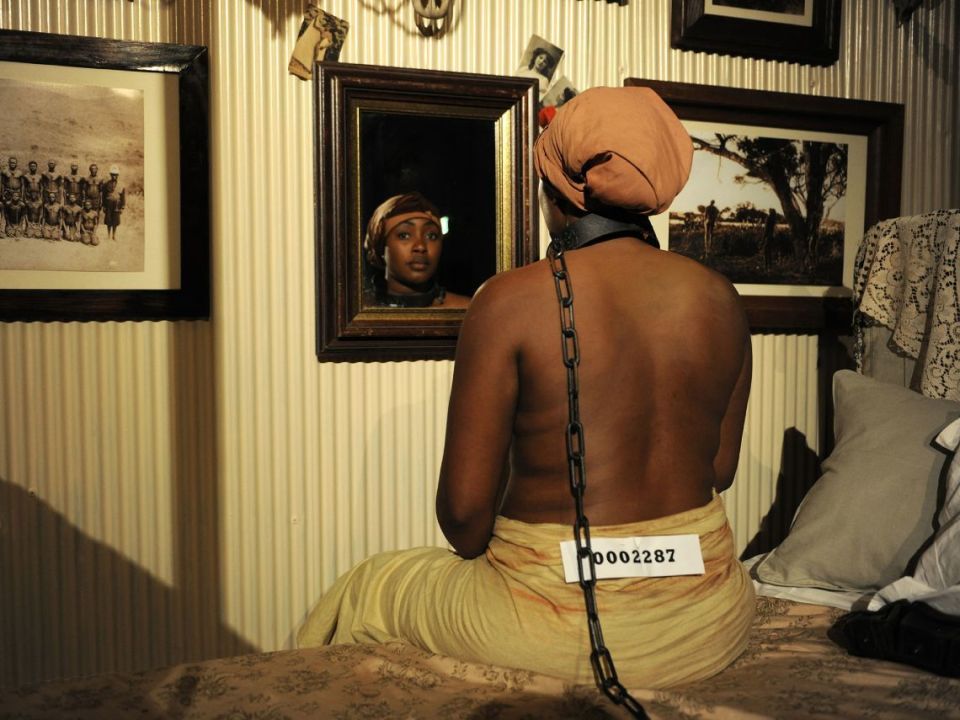
From Brett Bailey’s “Exhibit B”. This installation was based on an account of a French colonial officer who kept black women chained to his bed, exchanging food for sexual services.
Continuing my readings of Alastair Reid, while travelling in Chile, I find the following: “The fictions we make are ways of ordering and dominating the disorders of reality, even though they in no way change it. The ‘truth’ of a fiction is less important than its effectiveness; and since reality is shifting and changing, our fictions must constantly be revised.”
‘Fictions’ here has the broadest meaning possible, and should not be confined to those things that are written down and sold in the Fiction Section. Fictions, following Borges, are anything – a story, an explanation, a plan, a theory, a dogma – that gives a certain shape to reality. A piece of theatre, for example.
Arriving in Santiago from the south of Chile yesterday evening, I was invited by friends to attend a performance of Exhibit B, showing as part of the Santiago a Mil theatre festival. Exhibit B is a theatre installation that replicates the grotesque phenomenon of the human zoo during the 19th Century, in which Africans were put on display like circus freaks “for the titillation of European and American audiences under the guise of ‘ethnological enlightenment.’” The show created something of an outrage when performed at the Edinburgh Festival last year. There were complaints that the actors were being to subjected to a similar form of exploitation as the people whose lives they were reproducing, and its run at the Barbican in London was cancelled, on the grounds – according to the sociologist and activist Kehinde Andrews, writing in The Guardian – “that it reinforces, rather than challenges the racism it stands as a commentary on.”
Holding the performance in the baroque and excessive setting of the nineteenth century Cousiño Palace in central Santiago was a stroke of genius. The Cousiño Goyenechea family owned coal and silver mines, as well as the Cousiño-Macul Vineyards. The nouveau riche glitz of the palace set off by classical music, provided a sinister but peculiarly fitting locale.
The experience of Exhibit B was painful, as I expected it to be, and my emotions as I walked slowly round the exhibits were complex, and included a degree of shame in experiencing discomfort of any kind, given the extremes of discomfort, abuse and torture suffered by the subjects whose pained existences were being recreated by the actors. I was confused, as I was doubtless meant to be: should I make eye contact with the exhibits, for instance? Would I not be replicating the white man’s gaze that the performance so vehemently questions? The actors weren’t avoiding my gaze, that was for sure, and even on occasion followed my passage across the space in front of them, especially the replica of the man adopted by some Austrian prince in the 18th century who, when he died, had been skinned and stuffed (and blanched) and put out on display for visitors to admire.
My confusion – and the residual sense of shame which I had no power to resist – was exacerbated by a string of questions to which I had no answers. I think the most powerful message to come from this important work is that the objectification and exploitation of society’s others – and our continuing projection of otherness onto immigrants and asylum seekers – continues and will continue. We cannot change the past, but we can at least help shape the future. That is why I cannot support the position taken by the protesters who forced the closure of the Barbican show. A discussion between one of the black performers, Stella Odunlami, and Kehane Andrews (who was active in getting the show shut down, despite never having seen it) provides valuable arguments on both sides. Essentially though, I feel that censorship cannot be justified simply because a work of art chooses a difficult subject and questions reality in a way that some might find offensive.
By the criteria presented at the start of this post, that the fictions we make are ways of ordering and dominating the disorders of reality, even though they in no way change it, and that the ‘truth’ of a fiction is less important than its effectiveness, I can only say that in the case of Exhibit B, its effectiveness was not in doubt. It was both effective and a deeply moving testament to human cruelty and human suffering. As the performer Stella Odunlami writes in response to Kehane Andrews : “my fellow performers and I chose to be part of a production that exposed racism then and now. We have had to defend our decision to exercise our freedom of creativity to those who call us puppets. It is not your job to decide what is or isn’t good for me; I am capable of doing so for myself.” Brett Bailey’s own defence of the work can be found here.
At the very end, when we were standing around in the courtyard about to leave, I caught sight of the actors smoking and chatting by the side entrance of the palace. I was relieved that the company included the taxidermically conserved dead man whose gaze I had failed to meet. It was as if, with the actors out of role, no longer being the people they represented in fiction, their humanity had been restored to them, and with theirs, my own.
There are a hundred things to say about this, but th efact that Bailey claims to be an antiracist while systematically (in London, Paris, Toronto, Sao Paolo …) refusing debate with black organizations suggests what is really going on here.
LikeLike